Špela Petrič
Meta.Morf 2024 – [up]Loaded Bodies / Trøndelag Senter for Samtidskunst / April 17 – June 9 /
Curators: Zane Cerpina, Boris Debackere, Espen Gangvik, Florian Weigl.
PL’AI (2020)
“PL’AI” is an AI robot created to play with cucumber plants. Recognizing that crops are surveilled and controlled by algorithms as much as people, the project examines the potential of using machine learning, artificial intelligence, and robotics to relate to plants in a non-extractive manner; to resist the reductive view of plants as a living resource and use technology towards their joy—whatever it may be.
Špela Petrič sets out to question whether AI and machine learning tools, their high-tech sensorium, and bespoke effectors are, in fact, inescapably tied to utility and efficiency. Can we make an AI-powered robot whose purpose is to play with plants? And how do plants play anyway?
In contrast to a game with set rules, play evades clear definitions—play is relational, its bounds malleable, and its intensity in flux. It is through play that living beings learn about what their bodies can do, exploring with curiosity the freedom of agency prior to confronting existential challenges. And yet, what constitutes play also lies in the eyes of the beholder. Because it is so loosely defined and because the pleasure it brings to the entity playing is a first-person experience, it barely passes scientific scrutiny. Within the scientific episteme, ascribing vegetables with the potential of play would likely be considered an anthropomorphization that should be avoided. Since AI genealogically stems from technoscience based on objective knowledge, an AI robot built by people explicitly for the joy of beings as ontologically unrelated as plants are to humans poses a paradox. To add to the conundrum, Petrič considers the AI robot as a human prosthesis that augments some of the perceptual shortcomings of the human body that make it difficult to play with plants. The robot can both kinetically and cognitively enter plant time in a way we cannot.
With the expertise of people from the fields of computer and cognitive science, biology, engineering, design, art, and philosophy, the project attempts to make a morphologically and computationally plant-centered robot. The robot holds a planter with soil, above which 36 colorful bouncy balls are suspended from individually controlled wires. These are the effectors which the robot unwinds slowly to approach and play with the plants. Once the cucumbers start growing mature leaves, thin tendrils develop opposite each one. The tendrils are very motile, exploring their environment in a swaying motion, sensing touch, light, and perhaps even scents. If they come across a suitable object or surface (in this case, the robot’s wire) they wrap around it tightly and pull on it with a helical coiling mechanism.
While the visitor might not see play unfolding with their own eyes, they can catch a glimpse of it on the computer screen, which continuously replays the last 24 hours of interaction as a time-lapse video and reports on the latest steps taken by the AI robot.
As the cucumbers grow and envelop the robot, both become imprinted by the choices the other made in the process. Play as a moment in time seamlessly transitions into utility, the robot AI transforming into a trellis that allows the cucumber plants to stretch, flower, and fruit, eventually producing delicious cucumbers to be consumed by vegetable lovers. But by playing with machines in this manner, we become a little less deterministic, a little more plant-like, a little stranger, and a little less estranged from our digital spawn.
Credits
Programming: Benjamin Fele, Tim Oblak | Robot development & assembly: Gregor Krpič, Erik Krkač, Jože Zajc, David Pilipovič | Hands-on assistance: Meta Petrič, Bor Jarh | Consulting: Adriana Knouf | Text: Agnieszka Wolodzko | Narration: Blaž Šef | Design: Miha Turšič | Photo & video: Hana Jošić | Thanks to: Andrej Petrič, Zoran Srdić-Janežič, Waag, MU Hybrid Art House | Produced by: Kersnikova Institute / Kapelica Gallery within the framework of the European ARTificial Intelligence Lab | Further development of the project: Smart Hybrid Forms | Co-funded by: Creative Europe Programme of the European Union, Ministry of Culture of the Republic of Slovenia, Ministry of Public Administration of the Republic of Slovenia, City of Ljubljana – Department of Culture, Creative Industries Fund NL
 Špela Petrič (SI) is a Slovenian new media artist with a background in the natural sciences. Her artistic work combines biomedia practices and performativity to enact strange relations between bodies that reveal the underpinnings of our (bio)technological societies and propose alternatives.
Špela Petrič (SI) is a Slovenian new media artist with a background in the natural sciences. Her artistic work combines biomedia practices and performativity to enact strange relations between bodies that reveal the underpinnings of our (bio)technological societies and propose alternatives.
Petrič has received several awards, such as the White Aphroid for outstanding artistic achievement (Slovenia), the Bioart and Design Award (Netherlands), and an Award of Distinction at Prix Ars Electronica (Austria).
spelapetrič.org
Header Graphics: “PL´AI”, photo Hana Josič / Portait photo: Anze Sekelj.